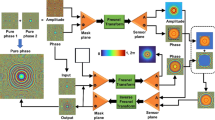Abstract
Random duty-cycle error (RDE) is inherent in the fabrication of ferroelectric quasi-phase-matching (QPM) gratings. Although a small RDE may not affect the nonlinearity of QPM devices, it enhances non-phase-matched parasitic harmonic generations, limiting the device performance in some applications. Recently, we demonstrated a simple method for measuring the RDE in QPM gratings by analyzing the far-field diffraction pattern obtained by uniform illumination (Dwivedi et al. in Opt Express 21:30221–30226, 2013). In the present study, we used a Gaussian beam illumination for the diffraction experiment to measure noise spectra that are less affected by the pedestals of the strong diffraction orders. Our results were compared with our calculations based on a random grating model, demonstrating improved resolution in the RDE estimation.


Similar content being viewed by others
References
S. Jesse, B.J. Rodriguez, S. Choudhury, A.P. Baddorf, I. Vrejoiu, D. Hesse, M. Alexe, M.E.A. Eliseev, A.N. Morozovska, J. Zhang, Nat. Mater. 7, 209–215 (2008)
Y. Furukawa, K. Kitamura, A. Alexandrovski, R.K. Route, M.M. Fejer, G. Foulon, Appl. Phys. Lett. 78, 1970–1972 (2001)
J.S. Pelc, C. Langrock, Q. Zhang, M.M. Fejer, Opt. Lett. 35, 2804–2806 (2010)
K. Nassau, H.J. Levinstein, G.M. Loiacono, J. Phys. Chem. Solids 27, 983–988 (1966)
M.M. Fejer, G.A. Magel, D.H. Jundt, R.L. Byer, IEEE Quantum Electron. 28, 2631–2654 (1992)
S. Kurimura, Y. Uesu, J. Appl. Phys. 81, 369–375 (1997)
Y.-S. Lee, T. Meade, M.L. Naudeau, T.B. Norris, Appl. Phys. Lett. 77, 2488–2490 (2000)
G.Kh. Kitaeva, V.V. Tishkova, I.I. Naumova, A.N. Penin, C.H. Kang, S.H. Tang, Appl. Phys. B 81, 645–650 (2005)
J.S. Pelc, C.R. Phillips, D. Chang, C. Langrock, M.M. Fejer, Opt. Lett. 36, 864–866 (2011)
K. Pandiyan, Y.S. Kang, H.H. Lim, B.J. Kim, M. Cha, Opt. Express 17, 17862–17867 (2009)
P.P. Dwivedi, H.J. Choi, B.J. Kim, M. Cha, Opt. Express 21, 30221–30226 (2013)
J.D. Gaskill, Linear System, Fourier Transforms, and Optics (Wiley, New York, 1978)
M. Abramowitz, I.A. Stegun, Handbook of Mathematical Functions (Dover, New York, 1964)
Acknowledgments
This work was supported by the Korea Research Institute of Standards and Science under the “Metrology Research Center” project.
Author information
Authors and Affiliations
Corresponding author
Appendix
Appendix
We show the derivation of the intensity pattern in Eq. (3), from the Fraunhofer diffraction amplitude pattern obtained by Fourier-transforming the transmission function in Eq. (2) and taking the ensemble average of the intensity.
Aside from the constant, the Fourier transform of Eq. (2) is directly obtained as
Substituting \(a_{k} = (w_{k}^{\text{r}} + w_{k}^{\text{l}} )/2\), \(b_{k} = c_{k} + (w_{k}^{\text{r}} - w_{k}^{\text{l}} )/4\), and \(c_{k} = \varLambda k\), Eq. (7) becomes
Then, the intensity pattern is calculated as
Here, we neglected the first term of Eq. (8), because it contributes only to the narrow region around ξ = 0 for a broad illumination (L ≫ Λ or N ≫ 1) and can be shown to have negligible influence on the spatial frequency range between the first order and the second order (X = Λξ = 1–2).
Next, based on the assumption that all w’s are independent statistical variables that follow a Gaussian distribution with a mean of \(\bar{w}\) and a standard deviation of σ, we calculate the ensemble average of the intensity pattern in Eq. (3). The average of a complex exponential function \({\text{e}}^{{i\pi \xi w_{k} }}\), for example, can be calculated as follows;
If the two random variables w k and w j are not mutually correlated, we have
and
Thus, Eq. (9) can be separately calculated in the two cases, j ≠ k and j = k, and then summed to give the ensemble-averaged intensity pattern.
For j ≠ k,
where
and we used a unitless spatial frequency X = Λξ in the final right-hand expression of Eq. (13).
For j = k,
Combining Eqs. (14) and (15), the ensemble-averaged intensity pattern becomes
Noting that \(\sum\nolimits_{k = - \infty }^{\infty } {{\text{e}}^{{ - 2\pi \left( {\frac{k}{N}} \right)^{2} }} }\) approaches \(N/\sqrt 2\), we arrive at the intensity pattern described by Eq. (3).
Rights and permissions
About this article
Cite this article
Dwivedi, P.P., Kumar, C.S.S.P., Choi, H.J. et al. Diffraction study of duty-cycle error in ferroelectric quasi-phase-matching gratings with Gaussian beam illumination. Appl. Phys. B 122, 34 (2016). https://doi.org/10.1007/s00340-015-6316-5
Received:
Accepted:
Published:
DOI: https://doi.org/10.1007/s00340-015-6316-5




